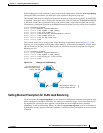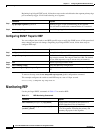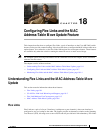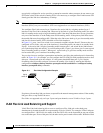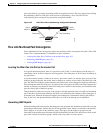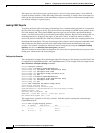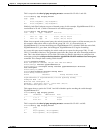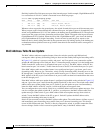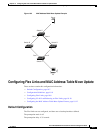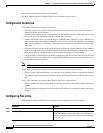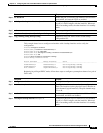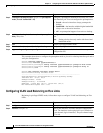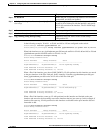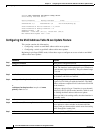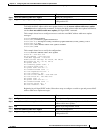
18-6
Cisco ME 3400 Ethernet Access Switch Software Configuration Guide
OL-9639-06
Chapter 18 Configuring Flex Links and the MAC Address-Table Move Update Feature
Understanding Flex Links and the MAC Address-Table Move Update
Similarly, both the Flex Link ports are a part of the learned groups. In this example, GigabitEthernet 0/10
is a receiver/host in VLAN 1, which is interested in two multicast groups:
Switch# show ip igmp snooping groups
Vlan Group Type Version Port List
-----------------------------------------------------------------------
1 228.1.5.1 igmp v2 Gi0/11, Gi0/12, Gi0/10
1 228.1.5.2 igmp v2 Gi1/0/11, Gi0/12, Gi0/10
Whenever a host responds to the general query, the switch forwards this report on all the mrouter ports.
When you turn on this feature through the command-line port, and when a report is forwarded by the
switch on GigabitEthernet 0/11, it is also leaked to the backup port GigabitEthernet 0/12. The upstream
router learns the groups and starts forwarding multicast data, which is dropped at the ingress because
GigabitEthernet 0/12 is blocked. When the active link, GigabitEthernet 0/11, goes down, the backup
port, Gigabitethernet t0/12, begins forwarding. You do not need to send any proxy reports as the
multicast data is already being forwarded by the upstream router. By leaking reports to the backup port,
a redundant multicast path has been set up, and the time taken for the multicast traffic convergence is
very minimal.
MAC Address-Table Move Update
The MAC address-table move update feature allows the switch to provide rapid bidirectional
convergence when a primary (forwarding) link goes down and the standby link begins forwarding traffic.
In Figure 18-3, switch A is an access switch, and ports 1 and 2 on switch A are connected to uplink
switches B and D through a Flex Link pair. Port 1 is forwarding traffic, and port 2 is in the backup state.
Traffic from the PC to the server is forwarded from port 1 to port 3. The MAC address of the PC has
been learned on port 3 of switch C. Traffic from the server to the PC is forwarded from port 3 to port 1.
If the MAC address-table move update feature is not configured and port 1 goes down, port 2 starts
forwarding traffic. However, for a short time, switch C keeps forwarding traffic from the server to the
PC through port 3, and the PC does not get the traffic because port 1 is down. If switch C removes the
MAC address of the PC on port 3 and relearns it on port 4, traffic can then be forwarded from the server
to the PC through port 2.
If the MAC address-table move update feature is configured and enabled on the switches in Figure 18-3
and port 1 goes down, port 2 starts forwarding traffic from the PC to the server. The switch sends a MAC
address-table move update packet from port 2. Switch C gets this packet on port 4 and immediately
learns the MAC address of the PC on port 4, which reduces the reconvergence time.
You can configure the access switch, switch A, to send MAC address-table move update messages. You
can also configure the uplink switches B, C, and D to get and process the MAC address-table move
update messages. When switch C gets a MAC address-table move update message from switch A,
switch
C learns the MAC address of the PC on port 4. Switch C updates the MAC address table,
including the forwarding table entry for the PC.
Switch A does not need to wait for the MAC address-table update. The switch detects a failure on port 1
and immediately starts forwarding server traffic from port 2, the new forwarding port. This change
occurs in 100 milliseconds (ms). The PC is directly connected to switch A, and the connection status
does not change. Switch A does not need to update the PC entry in the MAC address table.




